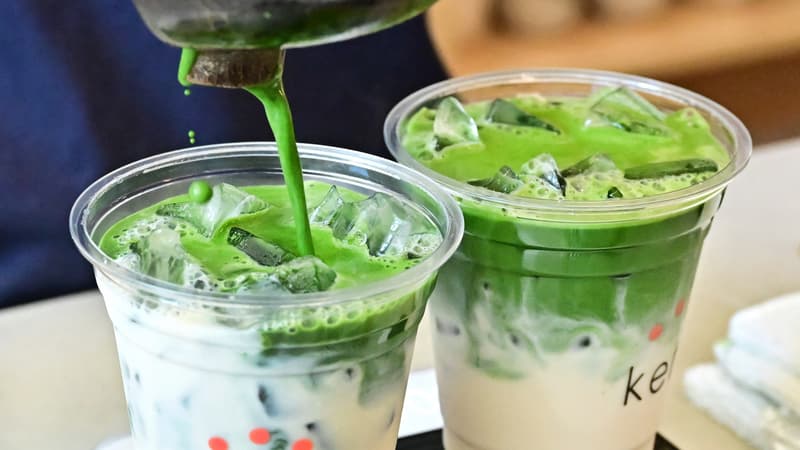In the hearts of Los Angeles, customers parade with “Kettl”, a minimalist matcha bar that opened its doors this year: elegant decoration, bamboo shelves, ceramic bowls and artisanal teteras, Japanese tea powder is preparing for him as a large cru. Matcha, the Japanese green tea dust produced from the dry and crushed leaves, has become the star of “well -being” drinks on social networks and tea stores.
In his establishment, Matcha can be served with milk, but nature is often preferred, scourged by hand, to better appreciate his aromas. Sold by a 20 grams package, the green dust costs between 23 and 140 euros, depending on the chosen variety.
In the one -year space, the production was found over a strong increase, which resulted in a flight of 198% of the price of this green powder in Japan, according to Zach Mangan. “Such volatility is unknown in the history of Japanese tea,” he says.
In social networks
In the city of Sayama, in the suburbs of Tokyo, Masahiro Okutomi, the head of the head of family tea exploitation, was also overwhelmed by applications. “I receive up to three messages per day. I had to mention on our site that we no longer accept any Matcha order,” said the producer. The manufacture of this “green gold” is a long and artisanal process: the leaves, called “tancha”, are grown in the shade for several weeks before the harvest, then are collected by hand and eliminate the ribs before being finely crushed.
“It has been training for years,” explains Masahiro Okutomi, evoking “long -term work that requires equipment, labor and investments.” Today he dedicates a third of his fields to green dust
The Matcha “Boom” has its origin in social networks, where content creators such as Andie, 600,000 subscribers on YouTube, popularized this explosive green drink. In the young and fashionable district of Harajuku, in Tokyo, the Frenchman opened an ephemeral store for her Matcha brand. Within the boutique with pastel decoration, dozens of fans rush to take a picture of themselves with the influencer and buy their math tea cans or white chocolate.
“Matcha is visually very attractive,” said the 23 -year -old youtuber. With eight employees, its brand released in November 2023 was a great success: 133,000 cans of Matcha, produced in the Mie region, have already been sold. And “demand only increases,” he said.
“They sent me to a mission”
In the tourist district of Tsukiji, in Tokyo, the tea store of judges, seeks to regulate its sales, confronted with an increasingly strong application. “We are not strictly imposing a limit (purchases), but sometimes we reject the sale of large quantities to suspicious customers of resale,” explains Shigehito Nishikida, head of the store.
On a trip to Japan, Anita Jordan, a 49 -year -old Australian tourist, abounds: “My children are obsessed with Matcha. They sent me to a mission to find the best,” he said.
In 2024, Matcha represented a little more than half of the 8,798 tons of exported green tea, according to figures from the Japanese Ministry of Agriculture, double ten years ago. The global market that is growing in 33% per year is expected to jump by 53% by 2029, according to forecasts of the consulting firm of the Business Research Company.
But this growth in the global Matcha market, estimated at 3 billion euros in 2024, is accompanied by concerns linked to commercial tensions.
“Customers say: I want Matcha, before there is no more,” said Zach Mangan in his Californian establishment.
In Japan, the average price of Techa reached the record of 44 euros per kilo (8,235 yen) during the first offer of the season in Kyoto, 1.7 times more than last year. The founder of Kettl fears another threat to American customs tasks in Japanese products that could go from 10 to 24% in July. “This is a difficult period. We try to absorb part of the costs, but there are limits. We cannot increase prices indefinitely,” he explains.
Fragile producers
In Japan, the situation of tea producers is still fragile: the number of farms has been divided by four in twenty years. “The question remains if we can produce in mass without sacrificing quality,” Masahiro Okutomi asks. The Japanese government is now encouraging tea producers to produce on a large scale to reduce costs. But in “small rural regions, it is almost impossible, he explains.” The formation of the new generation takes time … that cannot be improvised, “he adds.
Source: BFM TV


